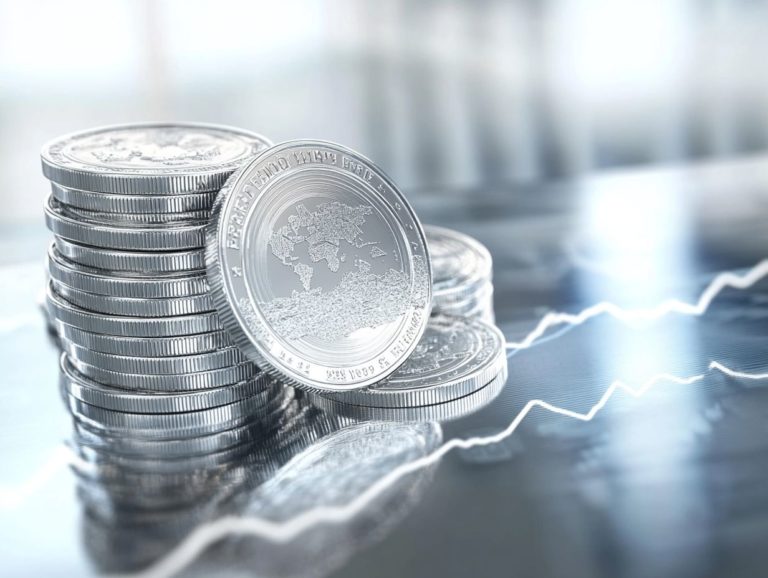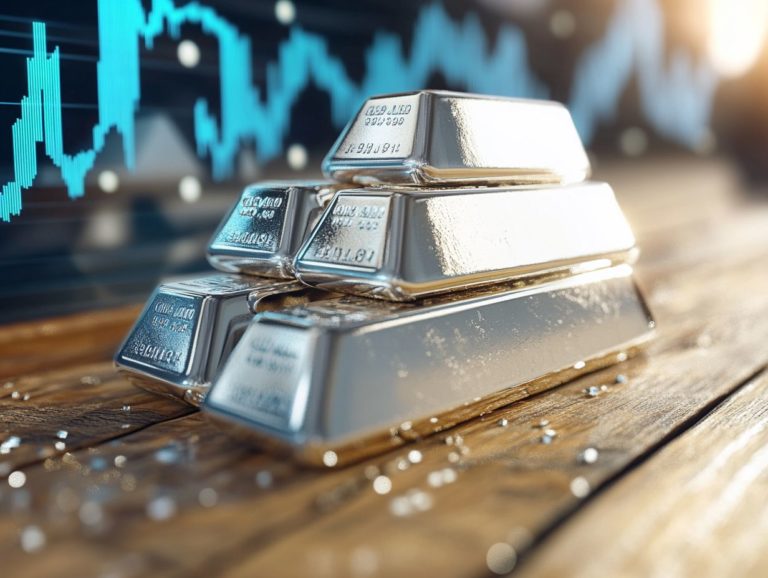5 Best Resources for Precious Metals Analysis
In the realm of precious metals, precise analysis is essential for maintaining quality control, making informed investment choices, and ensuring adherence to regulatory standards.
This article delves into five premier methods for assessing precious metals:
- X-Ray Fluorescence (XRF) Analyzer
- Inductively Coupled Plasma Mass Spectrometry (ICP-MS)
- Atomic Absorption Spectroscopy (AAS)
- Optical Emission Spectroscopy (OES)
- Fire Assay
Each of these methods offers distinct advantages, limitations, and specific applications. You ll gain insights into sample types, detection limits, costs, and how these techniques can enhance quality assurance within your operations.
Explore the details to determine which method aligns best with your requirements!
Contents
Key Takeaways:
- The XRF analyzer gives you quick, non-destructive results perfect for on-the-spot testing!
- ICP-MS delivers high sensitivity and accuracy, making it ideal for detecting tiny amounts of metals.
- AAS is a cost-effective and versatile method for measuring precious metal concentrations in various samples.
1. X-Ray Fluorescence (XRF) Analyzer
The XRF Analyzer is an essential tool for testing precious metals like gold and silver. It provides quick, reliable results that enhance your investment decisions and market analysis in the precious metals sector.
This method uses a non-destructive technique where X-rays excite the atoms in your sample, causing them to emit characteristic fluorescence. This fluorescence can be analyzed to determine the elemental composition.
XRF gives you quick results, allowing you to make informed choices swiftly. This can significantly impact your trading strategies and enable you to respond rapidly to market fluctuations.
Accurate assessment of precious metals sharpens your investment strategies and builds confidence in market dynamics. You gain clarity on metal quality and value, giving you the power to navigate the market with greater assurance.
2. Inductively Coupled Plasma Mass Spectrometry (ICP-MS)
ICP-MS is one of the most advanced analytical methods for detecting trace elements in precious metals. It offers the high precision essential for your investment research and asset allocation.
This technique uses super-hot gas to vaporize samples, enabling the detection of metals at parts-per-trillion levels. Its unmatched sensitivity and speed make ICP-MS your go-to choice over traditional methods like atomic absorption spectroscopy and inductively coupled plasma optical emission spectrometry.
While it does come with potential drawbacks, such as initial setup costs and the need for skilled technicians, the benefits are substantial.
Ideal samples for ICP-MS include liquid solutions and digested solids from precious metals. This significantly enhances its application in quality control processes. By delivering accurate measurements, ICP-MS helps uphold the integrity and value of your investments in precious metals.
3. Atomic Absorption Spectroscopy (AAS)
Atomic Absorption Spectroscopy (AAS) stands as a premier method for determining the concentration of precious metals like gold and silver. It uses their unique absorption characteristics, which helps you stay ahead of market trends and make informed investment decisions.
By measuring the light absorbed by vaporized samples, AAS utilizes the distinct wavelengths emitted by each element when energized. One of the standout features of AAS is its remarkable sensitivity, allowing it to detect concentrations as low as parts per billion.
This precision ensures that even trace levels of metals can be quantified. This capability is crucial for accurate market analysis.
However, AAS does have some challenges. It can face interference from other compounds and demands careful calibration.
In the sphere of precious metals investment, the accurate assessments provided by AAS empower you to make data-driven decisions. This helps you identify promising opportunities and mitigate risks in a fluctuating market landscape.
4. Optical Emission Spectroscopy (OES)
Optical Emission Spectroscopy (OES) is an invaluable tool for analyzing precious metals. It allows you to achieve precise assessments of elemental composition that are essential for market analysis and informed investment research.
By harnessing the principles of spectroscopy, OES evaluates the light emitted from excited atoms. This delivers reliable quantification of various metallic elements.
When compared to other techniques like X-ray fluorescence or mass spectrometry, OES stands out with its rapid results and heightened sensitivity. It enables you to detect trace elements that could have a profound impact on valuation.
While it does have limitations, such as potential interference from complex matrices and the necessity for sample preparation, the insights derived from OES empower you to make well-informed decisions about asset allocation in precious metals.
These insights illuminate trends and shifts in elemental composition that may affect market value. This guides your investment strategy with clarity and precision.
5. Fire Assay
Fire assay stands as the gold standard for determining the purity of precious metals, particularly gold and silver. Its historical reliability and accuracy make it an essential tool for quality control in the precious metals industry.
This age-old method, tracing back to ancient civilizations, utilizes heat to separate precious metals from impurities. This ensures that the results genuinely reflect the material’s true value.
The process involves a fusion technique, which uses lead and other fluxes to effectively capture the targeted metals, followed by cupellation to refine the results even further. Cupellation is a process that removes impurities from metals.
While this technique boasts high accuracy and the capability to handle complex ores, it isn’t without its drawbacks. The procedure can be time-consuming, and there s always a risk of sample loss.
For you as an investor, grasping the nuances of assay results is vital. Accurate measurements directly influence market decisions and future investments in precious metals.
What Are the Different Methods of Precious Metals Analysis?
Exploring the various methods of precious metals analysis reveals an impressive array of techniques designed to meet your specific needs. From X-Ray Fluorescence (XRF) to advanced methods like Inductively Coupled Plasma Mass Spectrometry (ICP-MS), each plays a pivotal role in shaping your investment decisions.
These analytical methods serve distinct purposes, addressing essential factors such as composition, purity, and trace element analysis all crucial for you as an investor aiming to maximize your returns.
For instance, XRF offers rapid, non-destructive testing. This makes it ideal for your preliminary assessments of metal content. In contrast, ICP-MS delivers unmatched sensitivity, allowing for meticulous trace analysis of precious metals.
Atomic Absorption Spectroscopy (AAS) adds another layer by precisely quantifying specific metals in a sample. Meanwhile, Optical Emission Spectroscopy (OES) excels in bulk metal analysis.
Let’s not forget that Fire Assay, often hailed as the gold standard for precious metals, provides high accuracy in determining valuable contents.
These methods are integral to crafting informed investment strategies and gaining a deeper understanding of market trends. Don’t miss out on essential insights that can boost your investment decisions!
What Are the Advantages and Disadvantages of Each Method?
Each method of precious metals analysis, from XRF to Fire Assay, presents its own unique set of advantages and disadvantages, influencing their suitability for various contexts such as investment strategies and market analysis.
Take X-ray fluorescence (XRF), for instance. It provides rapid and non-destructive testing.
However, its sensitivity can fluctuate based on the surface condition, which may render it less reliable for certain intricate evaluations.
In contrast, Fire Assay is revered as the gold standard for accuracy. However, it requires more time and significant sample preparation, which could potentially delay your investment decisions.
The effectiveness of these methods has a direct impact on quality control processes within the industry, ultimately guiding your purchasing choices based on your specific needs for precision, speed, or cost-efficiency.
Grasping these characteristics gives you the power to navigate the complexities of the precious metals market with confidence.
What Type of Samples Can Be Analyzed with Each Method?
The types of samples you can analyze with various precious metals testing methods differ, with certain techniques being more suitable for specific materials. This ensures you obtain accurate and reliable results when making investment decisions.
For example, if you’re dealing with ores, you’ll likely need to employ techniques such as fire assay or X-ray fluorescence to effectively determine their gold or silver content.
On the other hand, refined metals are often best assessed using methods like atomic absorption spectrometry, which is a technique that measures how much light is absorbed by atoms in a sample, helping to determine its purity.
Regarding alloys, a combination of methods is usually necessary to accurately identify the components.
Remember, the integrity of these samples plays a crucial role in your analytical outcomes; contamination or mishandling can easily lead to misleading results.
This accuracy directly influences your investment strategies, as precise assessments are essential for determining the true value of precious metals in your portfolio decisions.
What Are the Typical Detection Limits for Each Method?
Understanding the typical detection limits for each precious metals analysis method is essential for ensuring that your investment decisions are rooted in accurate and meaningful data.
Detection limits refer to the smallest amount of precious metals that a method can reliably identify.
These limits can greatly influence the reliability of quality control and assurance practices within trading and investing.
For example, some methods might only detect higher concentrations of precious metals, which could give you a false sense of security regarding the quality of an asset.
On the other hand, methods with lower detection limits can uncover minute impurities or variations that, while they may seem trivial, could significantly impact the overall value and market perception of your investment.
The effectiveness of each method influences your confidence as an investor and can dictate which analysis approach you choose based on your specific trading or investment strategy.
How Can These Methods Help with Quality Control and Assurance?
The various methods of precious metals analysis are essential for quality control and assurance, ensuring that your products meet the standards that influence both investment decisions and market perceptions.
From X-ray fluorescence (XRF) to fire assays, these methods do more than just verify the purity of metals they help establish trust between you and your consumers and investors.
By adhering to rigorous testing protocols, you can maintain product integrity and avoid costly discrepancies in an unpredictable market.
These implications are significant; accurate assessments directly impact pricing strategies and market trends, ultimately guiding you in your investment decisions.
As buyers increasingly require transparency and quality, these testing practices will reshape the precious metals trading landscape, fostering stronger market stability that benefits everyone involved.
Stay informed and make the best investment choices with the right analysis methods!
What Are the Costs Associated with Each Method?
Understanding costs in precious metals testing is vital for your investment decisions. These expenses can significantly affect your overall profitability.
Consider factors like the initial purchase price of testing equipment, ongoing material costs, and potential operational expenses. Advanced methods, such as X-ray fluorescence, may require a large upfront investment but provide quicker, more accurate results.
On the other hand, simpler techniques often have lower immediate costs but can lead to inaccurate assessments, risking your investment strategy.
By grasping these financial aspects, you can choose the best testing method to meet your financial goals and risk tolerance.
Frequently Asked Questions
What are the best resources for analyzing precious metals?
The top 5 resources for analyzing precious metals include:
- BullionVault: Offers real-time market data and analysis for gold, silver, platinum, and palladium.
- Kitco: A trusted source for precious metals news, charts, and quotes.
- Bloomberg: Provides in-depth financial analysis and news, including market trends and price movements.
- Metals Focus: A reputable independent research company delivering comprehensive reports and forecasts.
- World Gold Council: A key resource for global gold market data and trends.
How can I use these resources for my own analysis?
Use these resources to stay informed about market conditions, track price movements, and make smart investment choices. Their reports can help you understand market drivers and identify investment opportunities.
Do these resources cover all precious metals?
Yes, they cover a variety of precious metals including gold, silver, platinum, and palladium. Some also provide data for metals like rhodium, iridium, and ruthenium.
Are these resources reliable?
Absolutely! These sources are reputable and trusted in the industry. They consistently provide accurate and current information, widely used by investors and professionals.
Do I need to pay for access?
Some resources offer paid subscriptions for deeper insights. However, most basic information is available for free.
Can these resources help with investment decisions?
Yes, they offer valuable insights for making informed decisions. Remember to conduct your own research as well, aligning investments with your financial goals and risk tolerance.














